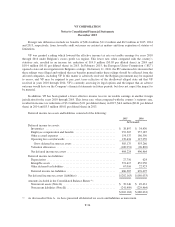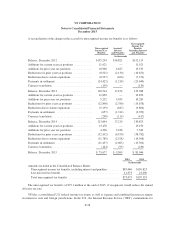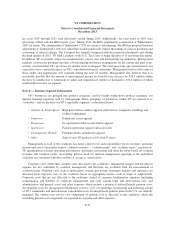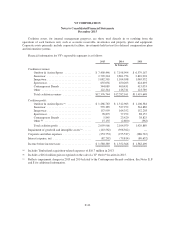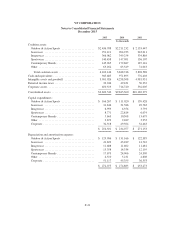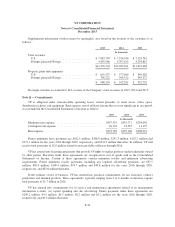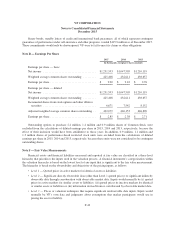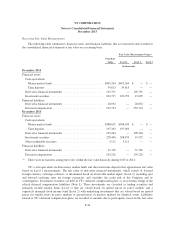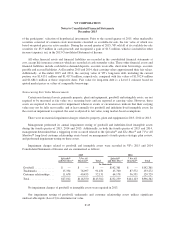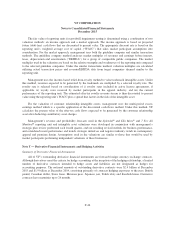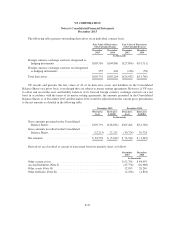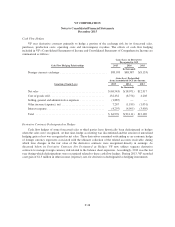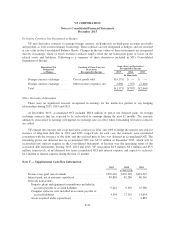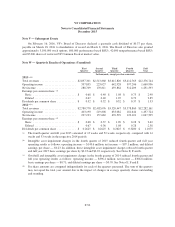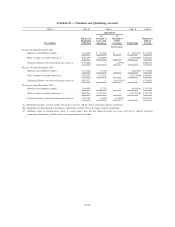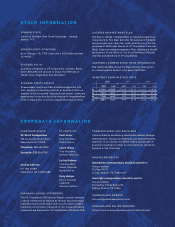North Face 2015 Annual Report Download - page 122
Download and view the complete annual report
Please find page 122 of the 2015 North Face annual report below. You can navigate through the pages in the report by either clicking on the pages listed below, or by using the keyword search tool below to find specific information within the annual report.VF CORPORATION
Notes to Consolidated Financial Statements
December 2015
The fair value of reporting units for goodwill impairment testing is determined using a combination of two
valuation methods: an income approach and a market approach. The income approach is based on projected
future (debt-free) cash flows that are discounted to present value. The appropriate discount rate is based on the
reporting unit’s weighted average cost of capital (“WACC”) that takes market participant assumptions into
consideration. For the market approach, management uses both the guideline company and similar transaction
methods. The guideline company method analyzes market multiples of revenues and earnings before interest,
taxes, depreciation and amortization (“EBITDA”) for a group of comparable public companies. The market
multiples used in the valuation are based on the relative strengths and weaknesses of the reporting unit compared
to the selected guideline companies. Under the similar transactions method, valuation multiples are calculated
utilizing actual transaction prices and revenue/EBITDA data from target companies deemed similar to the
reporting unit.
Management uses the income-based relief-from-royalty method to value trademark intangible assets. Under
this method, revenues expected to be generated by the trademark are multiplied by a selected royalty rate. The
royalty rate is selected based on consideration of i) royalty rates included in active license agreements, if
applicable, ii) royalty rates received by market participants in the apparel industry, and iii) the current
performance of the reporting unit. The estimated after-tax royalty revenue stream is then discounted to present
value using the reporting unit’s WACC plus a spread that factors in the risk of the intangible asset.
For the valuation of customer relationship intangible assets, management uses the multi-period excess
earnings method which is a specific application of the discounted cash flows method. Under this method, VF
calculates the present value of the after-tax cash flows expected to be generated by the customer relationship
asset after deducting contributory asset charges.
Management’s revenue and profitability forecasts used in the Splendid®and Ella Moss®and 7 For All
Mankind®reporting unit and intangible asset valuations were developed in conjunction with management’s
strategic plan review performed each fourth quarter, and our resulting revised outlook for business performance,
and considered recent performance and trends, strategic initiatives and negative industry trends in contemporary
apparel and premium denim. Assumptions used in the valuations are similar to those that would be used by
market participants performing independent valuations of these businesses.
Note T — Derivative Financial Instruments and Hedging Activities
Summary of Derivative Financial Instruments
All of VF’s outstanding derivative financial instruments are forward foreign currency exchange contracts.
Although derivatives meet the criteria for hedge accounting at the inception of the hedging relationship, a limited
number of derivative contracts intended to hedge assets and liabilities are not designated as hedges for
accounting purposes. The notional amounts of outstanding derivative contracts were $2.4 billion at December
2015 and $1.9 billion at December 2014, consisting primarily of contracts hedging exposures to the euro, British
pound, Canadian dollar, Swiss franc, Mexican peso, Japanese yen, Polish zloty and Swedish krona. Derivative
contracts have maturities up to 24 months.
F-46


